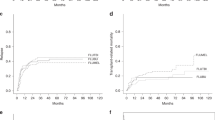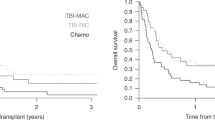Abstract
The aim of this prospective study was to investigate the feasibility of reduced-intensity conditioning (RIC) allogeneic stem cell transplantation (SCT) in 37 adults with high-risk acute lymphoblastic leukemia (ALL) in first (n=30) or second (n=7) complete remission (CR). All patients were treated with fludarabine (150 mg/m2) and melphalan (140 mg/m2) followed by transplantation from matched sibling (n=27) or unrelated (n=10) donors. The indications for reduced-intensity conditioning allogeneic SCT (RIC-SCT) were as follows: (1) ⩾50 years, 16 (43.2%) and (2) decreased organ function or active infections, 21 (56.8%). Graft-versus-host disease (GVHD) prophylaxis consisted of calcineurin inhibitor (cyclosporine for sibling and tacrolimus for unrelated transplants) and methotrexate. The cumulative incidence of acute (grades II–IV) and chronic GVHD was 43.2 and 65.6%, respectively. After a median follow-up of 36 months for surviving transplants, the 3-year relapse, non-relapse mortality, disease-free survival and overall survival rates were 19.7, 17.7, 62.6 and 64.1%, respectively. Transplants in first CR showed better transplantation outcomes than those in second CR. The potential of antileukemic activity of chronic GVHD was also found. This study suggests that RIC-SCT is a potential therapeutic approach for adults with high-risk ALL in remission who are ineligible for myeloablative transplantation.
This is a preview of subscription content, access via your institution
Access options
Subscribe to this journal
Receive 12 print issues and online access
$259.00 per year
only $21.58 per issue
Buy this article
- Purchase on Springer Link
- Instant access to full article PDF
Prices may be subject to local taxes which are calculated during checkout



Similar content being viewed by others
References
Takeuchi J, Kyo T, Naito K, Sao H, Takahashi M, Miyawaki S et al. Induction therapy by frequent administration of doxorubicin with four other drugs, followed by intensive consolidation and maintenance therapy for adult acute lymphoblastic leukemia: the JALSG-ALL93 study. Leukemia 2002; 16: 1259–1266.
Kantarjian H, Thomas D, O'Brien S, Cortes J, Giles F, Jeha S et al. Long-term follow-up results of hyperfractionated cyclophosphamide, vincristine, doxorubicin, and dexamethasone (Hyper-CVAD), a dose-intensive regimen, in adult acute lymphocytic leukemia. Cancer 2004; 101: 2788–2801.
Thomas X, Boiron JM, Huguet F, Dombret H, Bradstock K, Vey N et al. Outcome of treatment in adults with acute lymphoblastic leukemia: analysis of the LALA-94 trial. J Clin Oncol 2004; 22: 4075–4086.
Cornelissen JJ, Carston M, Kollman C, King R, Dekker AW, Lowenberg B et al. Unrelated marrow transplantation for adult patients with poor-risk acute lymphoblastic leukemia: strong graft-versus-leukemia effect and risk factors determining outcome. Blood 2001; 97: 1572–1577.
Hahn T, Wall D, Camitta B, Davies S, Dillon H, Gaynon P et al. The role of cytotoxic therapy with hematopoietic stem cell transplantation in the therapy of acute lymphoblastic leukemia in adults: an evidence-based review. Biol Blood Marrow Transplant 2006; 12: 1–30.
Yanada M, Matsuo K, Suzuki T, Naoe T . Allogeneic hematopoietic stem cell transplantation as part of postremission therapy improves survival for adult patients with high-risk acute lymphoblastic leukemia: a metaanalysis. Cancer 2006; 106: 2657–2663.
Mohty M, Bay JO, Faucher C, Choufi B, Bilger K, Tournilhac O et al. Graft-versus-host disease following allogeneic transplantation from HLA-identical sibling with antithymocyte globulin-based reduced-intensity preparative regimen. Blood 2003; 102: 470–476.
Martino R, Parody R, Fukuda T, Maertens J, Theunissen K, Ho A et al. Impact of the intensity of the pretransplantation conditioning regimen in patients with prior invasive aspergillosis undergoing allogeneic hematopoietic stem cell transplantation: A retrospective survey of the Infectious Diseases Working Party of the European Group for Blood and Marrow Transplantation. Blood 2006; 108: 2928–2936.
Shimoni A, Hardan I, Shem-Tov N, Yeshurun M, Yerushalmi R, Avigdor A et al. Allogeneic hematopoietic stem-cell transplantation in AML and MDS using myeloablative versus reduced-intensity conditioning: the role of dose intensity. Leukemia 2006; 20: 322–328.
Valcarcel D, Martino R, Caballero D, Martin J, Ferra C, Nieto JB et al. Sustained remissions of high-risk acute myeloid leukemia and myelodysplastic syndrome after reduced-intensity conditioning allogeneic hematopoietic transplantation: chronic graft-versus-host disease is the strongest factor improving survival. J Clin Oncol 2008; 26: 577–584.
Arnold R, Massenkeil G, Bornhauser M, Ehninger G, Beelen DW, Fauser AA et al. Nonmyeloablative stem cell transplantation in adults with high-risk ALL may be effective in early but not in advanced disease. Leukemia 2002; 16: 2423–2428.
Martino R, Giralt S, Caballero MD, Mackinnon S, Corradini P, Fernandez-Aviles F et al. Allogeneic hematopoietic stem cell transplantation with reduced-intensity conditioning in acute lymphoblastic leukemia: a feasibility study. Haematologica 2003; 88: 555–560.
Hamaki T, Kami M, Kanda Y, Yuji K, Inamoto Y, Kishi Y et al. Reduced-intensity stem-cell transplantation for adult acute lymphoblastic leukemia: a retrospective study of 33 patients. Bone Marrow Transplant 2005; 35: 549–556.
Mohty M, Labopin M, Tabrizzi R, Theorin N, Fauser AA, Rambaldi A et al. Reduced intensity conditioning allogeneic stem cell transplantation for adult patients with acute lymphoblastic leukemia: a retrospective study from the European Group for Blood and Marrow Transplantation. Haematologica 2008; 93: 303–306.
Lee S, Kim YJ, Min CK, Kim HJ, Eom KS, Kim DW et al. The effect of first-line imatinib interim therapy on the outcome of allogeneic stem cell transplantation in adults with newly diagnosed Philadelphia chromosome-positive acute lymphoblastic leukemia. Blood 2005; 105: 3449–3457.
Wassmann B, Pfeifer H, Goekbuget N, Beelen DW, Beck J, Stelljes M et al. Alternating versus concurrent schedules of imatinib and chemotherapy as front-line therapy for Philadelphia-positive acute lymphoblastic leukemia (Ph+ ALL). Blood 2006; 108: 1469–1477.
de Labarthe A, Rousselot P, Huguet-Rigal F, Delabesse E, Witz F, Maury S et al. Imatinib combined with induction or consolidation chemotherapy in patients with de novo Philadelphia chromosome-positive acute lymphoblastic leukemia: results of the GRAAPH-2003 study. Blood 2007; 109: 1408–1413.
Gökbuget N, Hoelzer D, Arnold R, Böhme A, Bartram CR, Freund M et al. Treatment of Adult ALL according to protocols of the German Multicenter Study Group for Adult ALL (GMALL). Hematol Oncol Clin North Am 2000; 14: 1307–1325.
Kantarjian HM, O'Brien S, Smith TL, Cortes J, Giles FJ, Beran M et al. Results with treatment with hyper-CVAD, a dose-intensive regimen, in adult acute lymphoblastic leukemia. J Clin Oncol 2000; 18: 547–561.
Przepiorka D, Weisdorf D, Martin P, Klingemann HG, Beatty P, Hows J et al. 1994 Consensus conference on acute GVHD grading. Bone Marrow Transplant 1995; 15: 825–828.
Klein JP, Rizzo JD, Zhang MJ, Keiding N . Statistical methods for the analysis and presentation of the results of bone marrow transplants. Part 2: regression modeling. Bone Marrow Transplant 2001; 28: 1001–1011.
Klein JP, Rizzo JD, Zhang MJ, Keiding N . Statistical methods for the analysis and presentation of the results of bone marrow transplants. Part I: unadjusted analysis. Bone Marrow Transplant 2001; 28: 909–915.
Gray RJ . A class of K-sample tests for comparing the cumulative incidence of a competing risk. Ann Stat 1988; 16: 1141–1154.
Stein A, Forman SJ . Allogeneic transplantation for ALL in adults. Bone Marrow Transplant 2008; 41: 439–446.
Stein A, Palmer J, O'Donnell M, Kogut N, Spielberger R, Slovak ML et al. Reduced-intensity allogeneic peripheral blood stem cell transplantation for high-risk acute lymphoblastic leukemia: a potential therapeutic approach for high risk ALL patients not eligible for full intensity transplantation. Blood 2008; 112: Abstract 4321.
Ringden O, Labopin M, Gluckman E, Reiffers J, Vernant JP, Jouet JP et al. Graft-versus-leukemia effect in allogeneic marrow transplant recipients with acute leukemia is maintained using cyclosporin A combined with methotrexate as prophylaxis. Acute Leukemia Working Party of the European Group for Blood and Marrow Transplantation. Bone Marrow Transplant 1996; 18: 921–929.
Zikos P, Van Lint MT, Lamparelli T, Gualandi F, Occhini D, Bregante S et al. Allogeneic hemopoietic stem cell transplantation for patients with high risk acute lymphoblastic leukemia: favorable impact of chronic graft-versus-host disease on survival and relapse. Haematologica 1998; 83: 896–903.
Nordlander A, Mattsson J, Ringden O, Leblanc K, Gustafsson B, Ljungman P et al. Graft-versus-host disease is associated with a lower relapse incidence after hematopoietic stem cell transplantation in patients with acute lymphoblastic leukemia. Biol Blood Marrow Transplant 2004; 10: 195–203.
Lee S, Kim DW, Kim YJ, Park YH, Min CK, Lee JW et al. Influence of karyotype on outcome of allogeneic bone marrow transplantation for adults with precursor B-lineage acute lymphoblastic leukaemia in first or second remission. Br J Haematol 2002; 117: 109–118.
Lee S, Kim DW, Cho B, Kim YJ, Kim YL, Hwang JY et al. Risk factors for adults with Philadelphia-chromosome-positive acute lymphoblastic leukaemia in remission treated with allogeneic bone marrow transplantation: the potential of real-time quantitative reverse-transcription polymerase chain reaction. Br J Haematol 2003; 120: 145–153.
Lee S, Cho BS, Kim SY, Choi SM, Lee DG, Eom KS et al. Allogeneic stem cell transplantation in first complete remission enhances graft-versus-leukemia effect in adults with acute lymphoblastic leukemia: antileukemic activity of chronic graft-versus-host disease. Biol Blood Marrow Transplant 2007; 13: 1083–1094.
Thomas DA, Faderl S, O'Brien S, Bueso-Ramos C, Cortes J, Garcia-Manero G et al. Chemoimmunotherapy with hyper-CVAD plus rituximab for the treatment of adult Burkitt and Burkitt-type lymphoma or acute lymphoblastic leukemia. Cancer 2006; 106: 1569–1580.
Carpenter PA, Snyder DS, Flowers MED, Sanders JE, Gooley TA, Martin PJ et al. Prophylactic administration of imatinib after hematopoietic cell transplantation for high-risk Philadelphia chromosome-positive leukemia. Blood 2007; 109: 2791–2793.
Slavin S, Naparstek E, Nagler A, Ackerstein A, Samuel S, Kapelushnik J et al. Allogeneic cell therapy with donor peripheral blood cells and recombinant human interleukin-2 to treat leukemia relapse after allogeneic bone marrow transplantation. Blood 1996; 87: 2195–2204.
Carlens S, Aschan J, Remberger M, Dilber MS, Ringden O . Low-dose cyclosporine of short duration increases the risk of mild and moderate GVHD and reduces the risk of relapse in HLA-identical sibling marrow transplant recipients with leukaemia. Bone Marrow Transplant 1999; 24: 629–635.
Locatelli F, Zecca M, Rondelli R, Bonetti F, Dini G, Prete A et al. Graft versus host disease prophylaxis with low-dose cyclosporine-A reduces the risk of relapse in children with acute leuekmia given HLA-identical sibling bone marrow transplantation: results of a randomized trial. Blood 2000; 95: 1572–1579.
Wassmann B, Pfeifer H, Stadler M, Bornhauser M, Bug G, Scheuring UJ et al. Early molecular response to posttransplantation imatinib determines outcome in MRD+ Philadelphia-positive acute lymphobalstic leukemia (Ph+ ALL). Blood 2005; 106: 458–463.
Acknowledgements
We acknowledge the financial support of the Catholic Medical Center Research Foundation made in the program year of 2007. The statistical analyses performed in this article were advised by Catholic Medical Center Clinical Research Coordinating Center.
Author information
Authors and Affiliations
Corresponding author
Rights and permissions
About this article
Cite this article
Cho, BS., Lee, S., Kim, YJ. et al. Reduced-intensity conditioning allogeneic stem cell transplantation is a potential therapeutic approach for adults with high-risk acute lymphoblastic leukemia in remission: results of a prospective phase 2 study. Leukemia 23, 1763–1770 (2009). https://doi.org/10.1038/leu.2009.102
Received:
Revised:
Accepted:
Published:
Issue Date:
DOI: https://doi.org/10.1038/leu.2009.102
Keywords
This article is cited by
-
Experience of blinatumomab salvage for patients with acute lymphoblastic leukemia presenting with isolated extramedullary relapse after previous allogeneic hematopoietic cell transplantation
Bone Marrow Transplantation (2020)
-
Comparison of reduced-intensity conditioning regimens in patients with acute lymphoblastic leukemia >45 years undergoing allogeneic stem cell transplantation—a retrospective study by the Acute Leukemia Working Party of EBMT
Bone Marrow Transplantation (2020)
-
Reduced Intensity Conditioning Allogeneic Hematopoietic Stem Cell Transplantation for Acute Lymphoblastic Leukemia; Current Evidence, and Improving Outcomes Going Forward
Current Hematologic Malignancy Reports (2018)
-
Allogeneic hematopoietic stem cell transplantation in adult acute lymphoblastic leukemia: potential benefit of medium-dose etoposide conditioning
Experimental Hematology & Oncology (2015)
-
Impact of IKZF1 deletions on long-term outcomes of allo-SCT following imatinib-based chemotherapy in adult Philadelphia chromosome-positive ALL
Bone Marrow Transplantation (2015)



